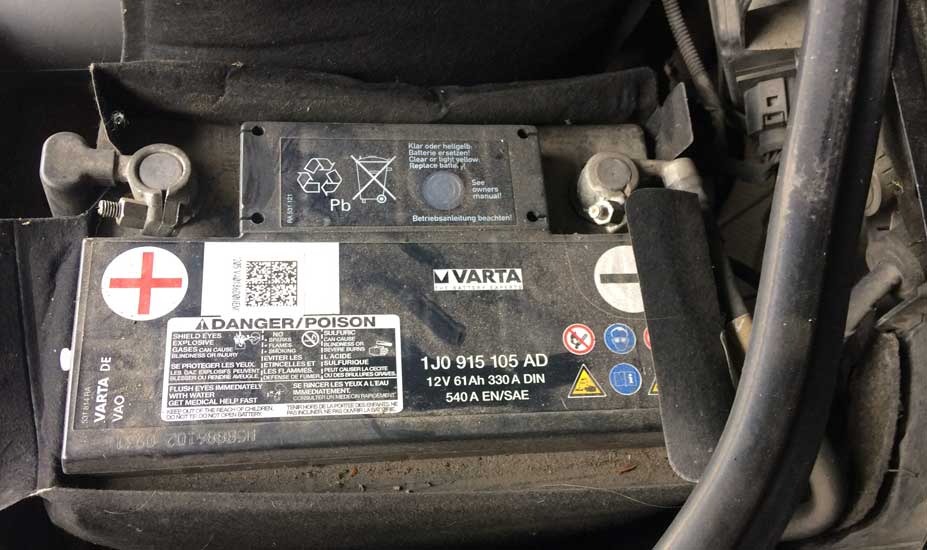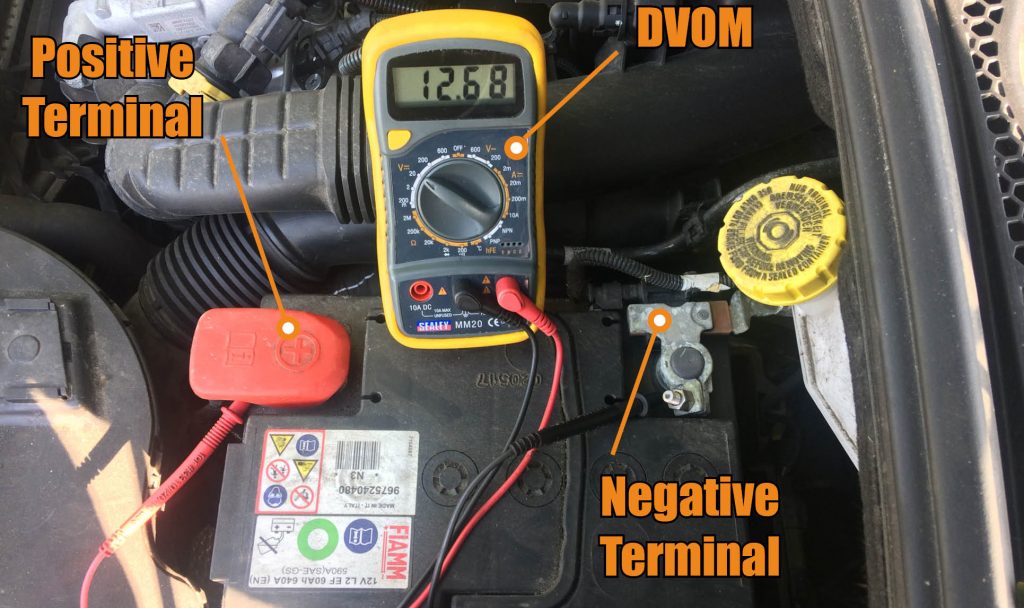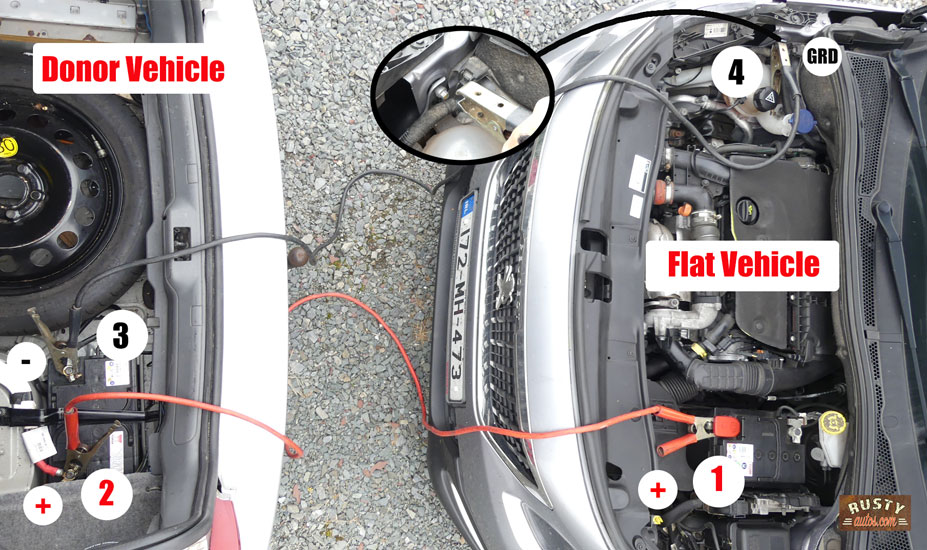What Color Is the Positive on a Battery

Car batteries, without them we're going nowhere, knowing which terminal is which can be a head-scratcher, but five minutes from now, you'll be an expert.
Car battery terminals will be marked and color-coded. The color red and the plus sign for the positive terminal and the color black and the minus sign for the negative terminal. The negative terminal connects to the vehicle's metal chassis.
In this post, I'll show you clearly which terminal is which, how to fit a battery, and what to do if you connect it back ways. You'll also learn how to Jumpstart your car.
How Can You Tell Which Terminal Is Which?

The negative terminal is color-coded black and will be connected to the minus side of the battery. The minus will be stamped into the battery plastic casing, you may need to look closely. The negative terminal may or may not have a plastic cover over the terminal connector.
The negative wiring insulator will be colored black and the negative terminal attaches directly to the negative side of the battery and to the metal chassis of the car.

The positive terminal is colored red and will be connected to the plus side of the battery. The plus sign will be stamped into the plastic battery casing, it may be difficult to spot at first, but it is there.
The positive terminal will likely have a red plastic cover shielding the terminal, it will likely also be marked with a plus sign. The positive wiring insulator will be colored red.


How To Test A Car Battery?
Battery failure is common, but so too is assuming a flat battery means your battery is faulty. Misdiagnosing a battery can be an expensive mistake.
Checking battery voltage as per the above picture is OK but a battery that shows a full 12.65 volts could still be faulty. The only way to be sure is to test the battery under load.
The process is simple, but you'll need a helper and a Dvom (voltmeter). The graphic below shows the process, but you'll need to start the test with a fully charged battery. This test won't work if the battery is flat.

Step 1 – Charge battery to 12.65 volts
Step 2 – Set the voltmeter to 20v DC
Step 3 – Connect the voltmeter as per the graphic above
Step 4 – Have the helper crank engine
Step 5 – A reading on the voltmeter below 9 volts indicates a faulty battery
How To Replace A Car Battery
A car battery will have a fastener on each terminal and a third fastener, the battery hold down, it secures the battery to the chassis of the car.
Mistake to avoid:
But before removing any terminals, you should check your driver's manual, some cars may require calibrating of windows and steering, and some will need a throttle to relearn and that may require a trip to the shop. I wrote a whole post about recalibrating – Car won't idle after dead battery.
The more sophisticated the car the more likely disconnecting the battery will cause issues.

You can avoid all these potential issues by using KAM (Keep Alive Memory), it's a simple device that keeps power in the car while the battery is removed.
The Schumacher memory saver tool is great, easy to use, pay for itself with just a single-use, and is conveniently available on Amazon.com.
Step 1: Plug in your KAM device if needed
Step 2: Now we're ready to change the battery, remove the battery hold-down bolt, it will likely be one bolt at the base of the battery
Step 3: Remove the black, negative, minus terminal first
Step 4: Now remove the red, positive, plus terminal
Step 5: Remove the old and fit the new battery
Step 6: Fit the red, positive battery terminal
Step 7: Fit the black, negative battery terminal
Step 8: Secure the battery with the hold-down bracket
You should note, modern cars employ a battery control module that requires coding to the new battery. A scan tool is required to code the battery to control the module. Your vehicle will still operate without coding the battery but it will shorten the battery life.
Anyway it's all covered in the post I wrote about fitting a car battery including pictures and you can check it out here "How hard to fit car battery".
How To Jumpstart A Car

You'll need a donor vehicle or a spare battery or alternatively consider buying a jump pack. The little NOCO boost pack is about the best I've seen and I'm a mechanic for over twenty-five years.
It's small enough to fit in a glove box and powerful enough to start a diesel engine. Anyway, you can check it out here on the Auto electrical tools page.
To jump it with a regular set of jumpers follow these steps.
Donor car or any fully charged 12-volt battery, the jump-starting procedure is simple. Red positive (+) to red positive booster cable first, then connect the negative black (-) to both battery and chassis or engine ground. A ground is any bare metal on the chassis or engine.

Step 1:
Move a donor car close enough to connect booster cables.
Step 2:
Put the jumper cables on in sequences 1, 2, 3, 4.
Step 3:
Start the donor car and leave it idling.
Step 4:
Now start your car and leave the cables attached and your car idling for a few minutes before removing.
Step 5:
Now with the engine running, remove the jumpers in reverse order 4, 3, 2, and 1.
Hooked Up Battery Cables Backwards

This is a common enough problem, as is hooking up jumper cables the wrong way. Don't panic, we'll figure it out!
Your symptoms could range from:
- No power at all, anywhere
- Ignition lights work, but the engine won't crank
- Car cranks but won't start
- Electrical gremlins since the wrong battery hookup
Hooking the cables up backward will usually blow the main fuse. Fuses are fitted in the under-hood fuse box, interior fuse box, and possibly a trunk fuse box.
First, locate your handbook or Google where your fuse boxes are and you'll also need to know the individual fuse locations.

If you have no power at all, anywhere, first verify that your battery is OK. You can do this by checking it with a voltmeter (12.65v is full) or using booster cables from a fully charged 12v battery, use the jump-starting guide above.
You can find a simple handheld battery tester listed here on the "Auto electrical repair tools page" and if you need easy-to-use, convenient boost starting tools, check out the Amazon link below.
Amazon Boost Starting Tools
If the battery checks out then go ahead and check the fuses.

A blown fuse will have a broken element, visible through the plastic body. A tweezers tool fitted to the inside fuse box cover will help with removal. Your fuses may not look identical to those shown here, but you get the idea.
Look for the following fuses, you won't have all of these but check whichever one's you've got.
- Main fuse
- Battery monitoring fuse
- Ecu/Ecm/Pcm fuse
- Cem fuse
- Instrument panel fuse
- Car fuse bank
If your ignition lights work, but the engine won't crank, check the following fuses:
- Main fuse
- Anti-theft fuse
- Immobiliser fuse
- Ecu/Ecm/Pcm fuse
- Starter motor relay/fuse
- Ignition fuse
If none of this helped, check out this post, it covers fault finding a no crank "Car won't start clicking noise"

If your car cranks but won't start, check the following fuses:
- Main fuse
- Anti-theft fuse
- Immobiliser fuse
- Ecu/Ecm/Pcm fuse
- Ignition coil fuse
- Fuel pump fuse
- Fuel injector fuse

Having a workshop manual for your vehicle is always a good plan, they only cost a few dollars but will save you a packet. A good manual will cover your vehicle in detail, repair and replacement procedures, electrical wiring diagrams, system overview, troubleshooting section, and fastener torque specs, etc. all mission-critical info.
Related Questions
Which terminal is ground on a car battery? The ground terminal is the black, minus terminal on the battery, also known as the negative or ground terminal. It connects the vehicle chassis to the minus side of the battery.
What Color Is the Positive on a Battery
Source: https://rustyautos.com/unmarked-car-battery-terminals/